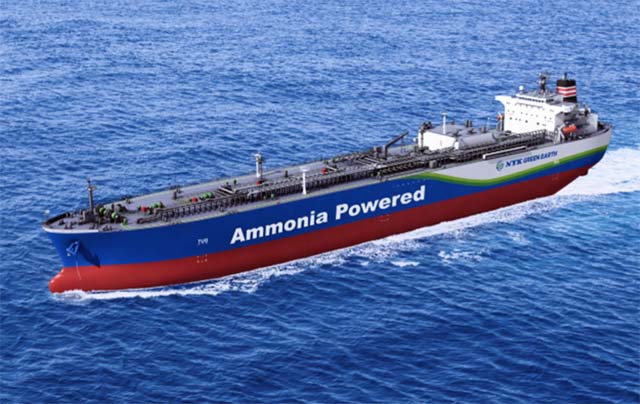Nippon Yusen Kabushiki Kaisha (NYK), Japan Engine Corporation (J-Eng), IHI Power Systems and Nihon Shipyard, having previously signed a series of contracts to construct the world’s first ammonia-fuelled medium gas carrier (AFMGC) equipped with Japan-made engines, have now said that the vessel is scheduled to be completed in November 2026.
The completion of the vessel is said to be a significant step toward the realisation of decarbonisation in the maritime sector. In October 2021, the four companies were selected by Japan’s New Energy and Industrial Technology Development Organization (NEDO) for its Green Innovation Fund Project, and together with Nippon Kaiji Kyokai (ClassNK), the five parties (the Consortium) have been working on the demonstration project for commercialisation of vessels equipped with a domestically produced ammonia-fuelled engine. The consortium says that Japan’s maritime industry is now in full swing to lead the world with the AFMGC toward its completion in November 2026.
Through the development and construction of the AFMGC, the Consortium will contribute to the practical application of ammonia-fuelled ships. Ammonia is expected to be used as a hydrogen carrier, and demand for ammonia is expected to grow rapidly in Japan and overseas. At the same time, demand for ammonia production and marine transportation will increase, and an ammonia value chain is expected to be established sequentially. Based on the belief that establishing a cleaner, less environmentally burdensome ammonia value chain is indispensable for realising a decarbonised society, the Consortium will work to complete and popularise the AFMGC and other ammonia-fuelled ammonia carriers.
The maritime industry is seen as essential to Japan’s economic security. The consortium sees fuel conversion to achieve zero emissions as an opportunity and aims to use the technological capabilities of the Japanese maritime cluster to supply ships with high environmental performance and safety ahead of other countries.
This Project is among the first to develop ammonia-fuelled ships, and the knowledge gained will be essential to the progress of discussions at the IMO. The Consortium aims to work closely with ClassNK and Japan’s Ministry of Land, Infrastructure, Transport and Tourism (MLIT) to contribute actively to international rulemaking.
The vessel will have a capcity of 40,000m³ and will be built at Japan Marine United Corporation’s Ariake Shipyard. The ammonia dual-fuel two-stroke main engine will be developed by J-Eng, and the dual-fuel four-stroke auxiliary engine by IHI Power Systems.
Ammonia engines require fuel oil as pilot fuel, while a high ammonia co-firing ratio is required to achieve a high GHG reduction rate. The consortium aims to achieve an ammonia fuel mixed combustion rate up to 95% in the main engine and 80% or more in the auxiliary engines. Safety, with due regard to the toxicity of ammonia, is a challenge in the ship design philosophy, and for the engine designs developing advanced technologies for stable combustion wil be necessary. To limit emissions of nitrous oxide (N2O), a very potent greenhouse gas, new technology will be needed to reduce and treat N2O emissions.
A design for a prototype vessel that overcame these challenges obtained an Approval in Principle (AiP) from ClassNK in September 2022, while a risk assessment and safety measures proposal has been carried out, led by NYK engineers. ClassNK has now published safety guidelines for ammonia-fuelled ships.
Experiments in 2023 by IHI Power Systems and J-Eng have shown that the consortium is on track to achieve the required environmental performance from the engines. After the ship is completed, the consortium will operate the vessel for demonstration purposes to confirm the vessel’s performance, including environmental friendliness and the practicality of operation manual, and to provide user feedback to shipbuilders and marine equipment manufacturers for further improvements.
Image: Japan’s ammonia-fuelled gas carrier design (source: J-Eng)



